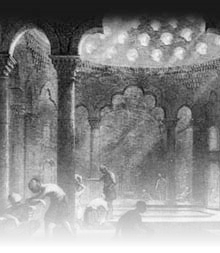










Definition of Hamam (Turkish Bath):
A Turkish bath (Turkish: hamam) is the Turkish variant of a steam bath,
sauna or Russian bath, distinguished by a focus on water, as distinct from
ambient steam. In Western Europe, the 'Turkish bath' as a method of
cleansing and relaxation became popular during the Victorian era. The
process involved in taking a Turkish bath is similar to that of a sauna, but is
more closely related to ancient Greek and ancient Roman bathingpractices. A
person taking a Turkish bath first relaxes in a room (known as the warm
room) that is heated by a continuous flow of hot, dry air allowing the bather
to perspire freely. Bathers may then move to an even hotter room (known as
the hot room) before splashing themselves with cold water. After performing
a full body wash and receiving a massage, bathers finally retire to the
cooling-room for a period of relaxation.
The hamam, like its precursors, is not exclusive to men. Hamam complexes
usually contain separate quarters for men and women; or males and females
are admitted at separate times. Because they were social centers as well as
baths hamams became numerous during the time of the Ottoman Empire
and were built in almost every Ottoman city. On many occasions they
became places of entertainment (e.g. dancing and food, especially in the
women's quarters) and ceremonies, such as before weddings, high-holidays,
celebrating newborns, beauty trips. Nowadays, architects are desinging
unisex hamams according to requests.









Architecure History
The hamam combines the functionality and the structural elements of its predecessors in Anatolia, the Roman thermae
and baths, with the Central Asian Turkic tradition of steam bathing, ritual cleansing and respect of water. It is also known
that Arabs built versions of the Greek-Roman baths that they encountered following their conquest of Alexandria in 641.
From the 10th century, Turkish kingdoms began to proliferate in Anatolia in lands conquered from the Byzantine Romans,
leading eventually to the complete conquest of the remnants of the old empire in the 15th century. During those
centuries of war, peace, alliance, trade, and competition, the two cultures — Hellenized Roman and Anatolian Turkish —
had tremendous influence on each other. Moving beyond the re-use of the Roman baths in their new lands, new bath
were constructed as annex buildings of mosques, the complexes of which were community center as well as houses of
worship.
The Ottomans in particular became prolific patrons of baths, building a number of ambitious structures, particular in
Constantinople after it became their capital in 1453. The monumental baths designed by Renaissance Ottoman architect
Mimar Sinan (1489–1588), such as the stand alone 1584 "Çemberlitaş Hamamı", the bath in the complex of the 1558
Süleymaniye Mosque (both in Constantinople, the modern Istanbul) and the bath of the Selimiye Mosque in Edirne were
particularly influential.
1 l 2